An easy cultured vegan yogurt recipe that's smooth, tangy, exceptionally thick & creamy, and perfect for dolloping on anything and everything! Easy to make with or without an Instant Pot.
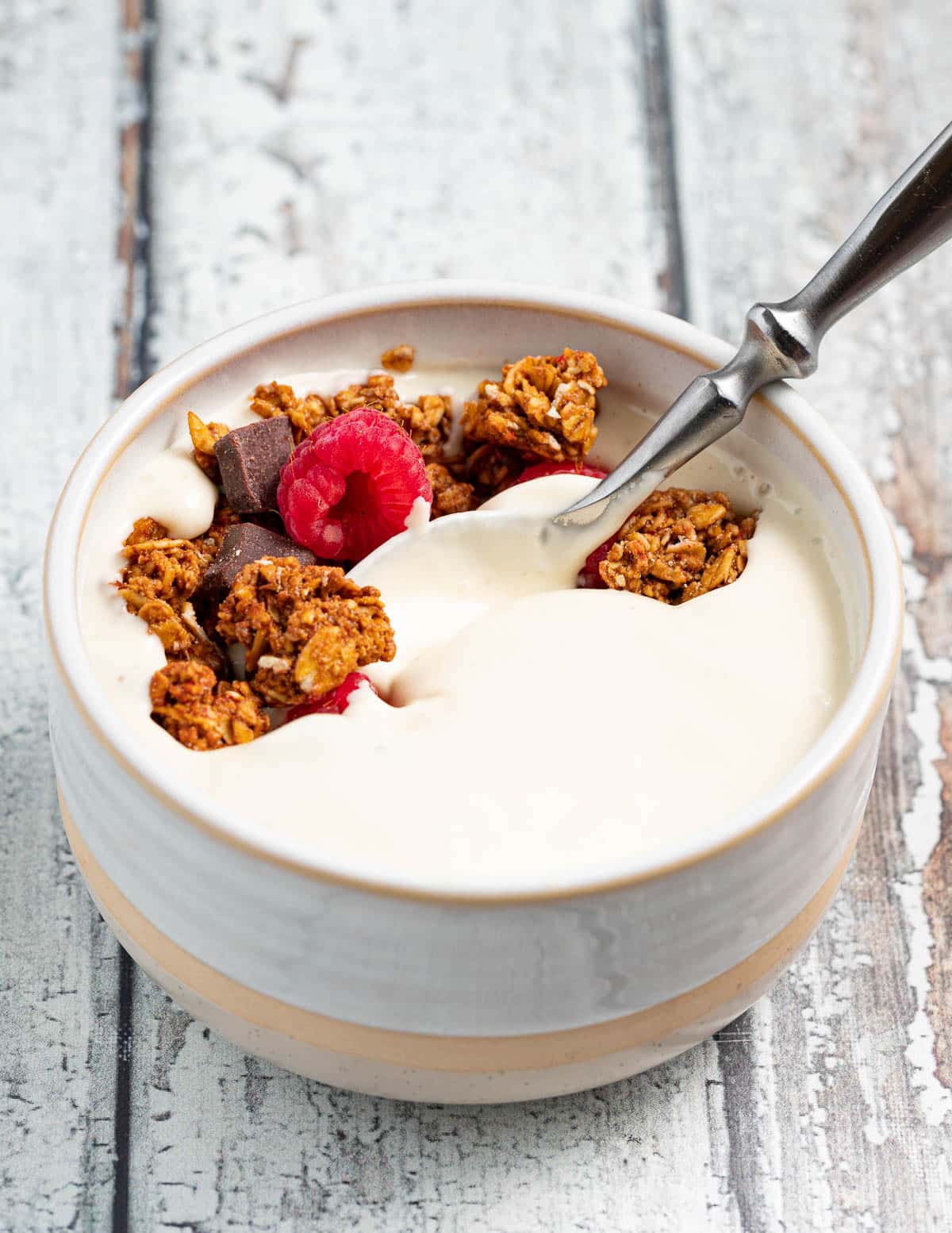
💌 SAVE THIS RECIPE!
Watch out for more tasty treats coming your way too! Unsubscribe at any time.
We're jumping back on the fermentation train for this vegan yogurt recipe. And it's a whole lot quicker and easier than making a sourdough starter or sourdough bread so you're A-Ok!
And this vegan yogurt is so good! We're talking sheer yogurt decadence. It's smooth and tangy, and unlike many other homemade vegan yogurt recipes, it is exceptionally thick and creamy.
Yep, this cultured vegan yogurt recipe is THICK. And it continues to thicken as it sits in the fridge. If you leave it there for a few days it becomes almost Greek yogurt-like. And you won't need any expensive probiotics, powdered starters, or thickeners like agar, tapioca, or xanthan gum to make it either!
Mel x
Jump to:
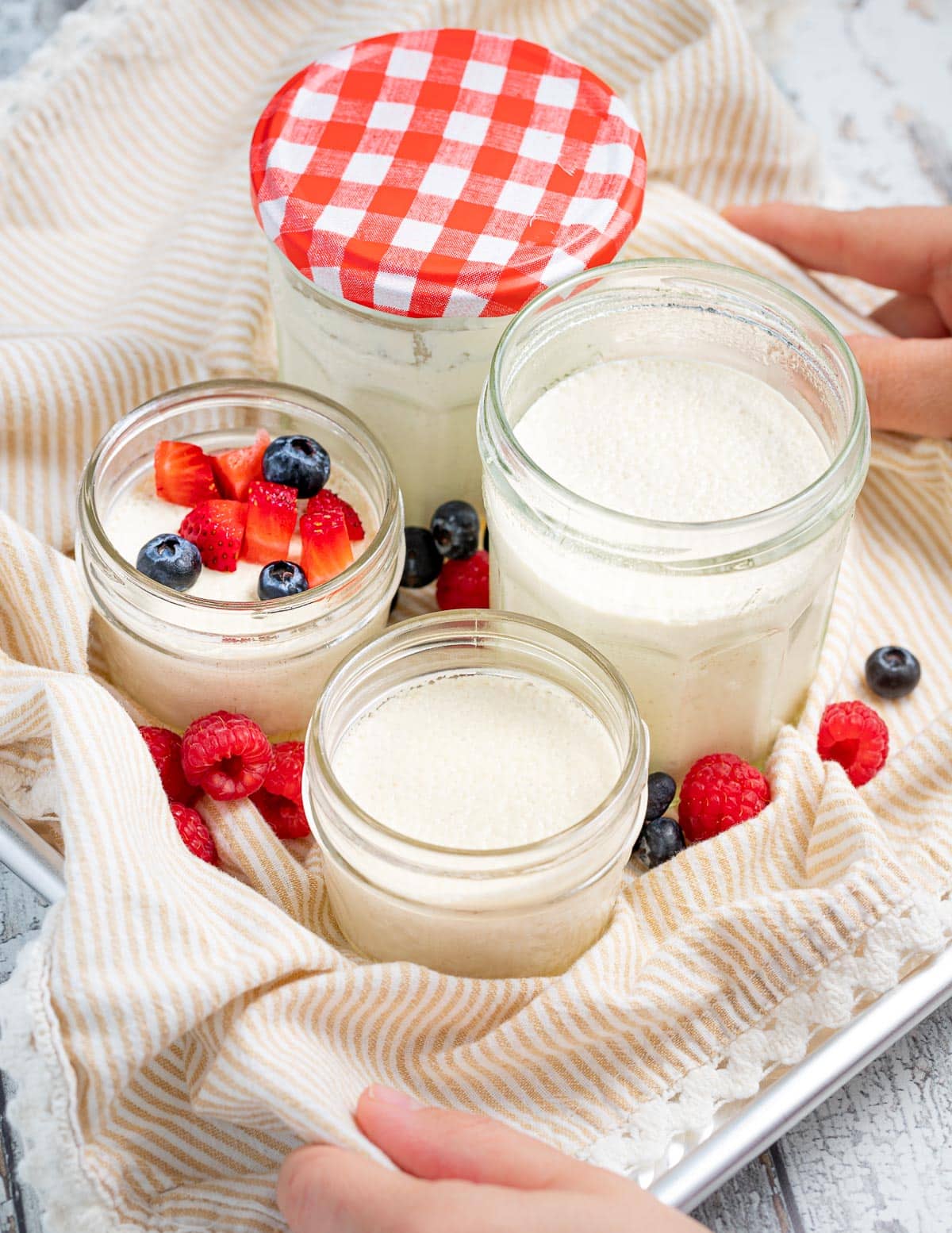
Ingredients
Are you wondering how you can possibly make vegan yogurt without probiotics or special yogurt starters? I'll let you in on my secrets.
These are the ingredients you need to make my vegan yogurt recipe and a little about why you need them:
- Light canned coconut milk - Light canned coconut milk gives consistent results and makes the yogurt rich, decadent, thick, and creamy without an obvious coconut taste. I do not recommend you use any other milk.
- Raw cashew nuts - These add a lovely cashew flavour and also work to make this yogurt extra thick and creamy.
- A tiny bit of store-bought vegan yogurt - This acts as the starter. It contains the live cultures that will ferment your yogurt. You only need this the first time you make it. For subsequent batches, you can use a little of your homemade vegan yogurt instead.
- Maple syrup - Maple syrup is always my first choice because it is so natural and unprocessed, but agave or white/cane sugar will work too. Sugar in some form is necessary for the bacteria to feed on. It won't make your yogurt sweet because by the time it is cultured the bacteria will have consumed it.
You will also need some glass jars with lids. I use cleaned up empty jam jars. I don't recommend making this recipe directly in the inner pot of an Instant Pot.
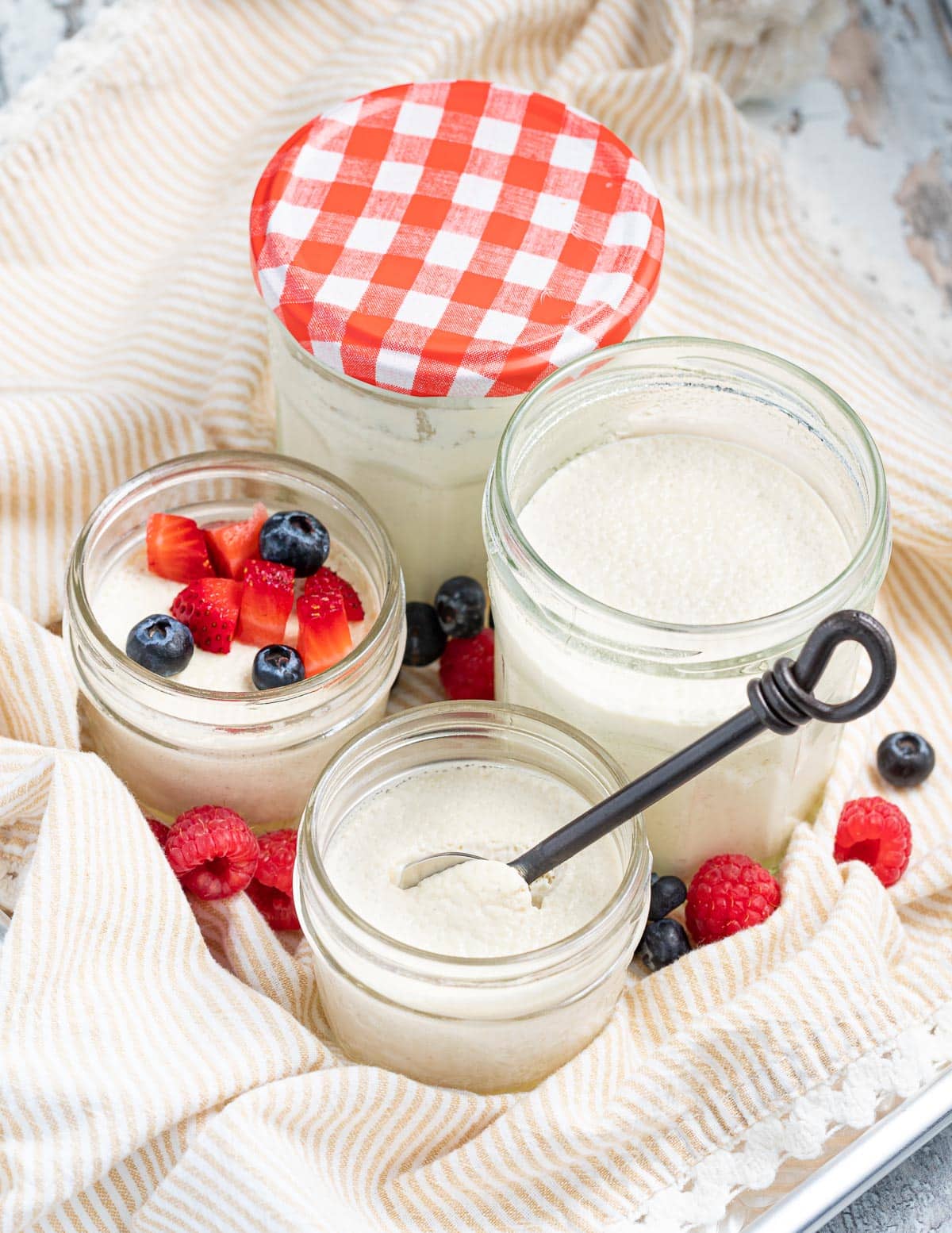
Do I Need An Instant Pot To Make Vegan Yogurt?
An Instant Pot with a designated yogurt button provides the perfect environment for making this vegan yogurt recipe and it is the quickest method too. You don't have to use one though. You can make it without an Instant Pot and instructions are included.
How To Make Vegan Yogurt
Want to know how to make the best vegan yogurt? It's much easier than you might think and you can make it with an Instant Pot or without one.
Here's exactly how it's done with step-by-step pictures:
1 - Soak the cashews then add them to a blender with the other ingredients. Blend until completely smooth.

2 - Decant into jars then place in an Instant Pot on the yogurt setting or leave in a warm place to ferment.

3 - Chill thoroughly before serving. When you remove it from the fridge it will be very thick. The longer you leave it there the thicker it will get. Here's what it will look like when you first spoon some out:

4 - Stir it and it will become super, silky smooth like this:
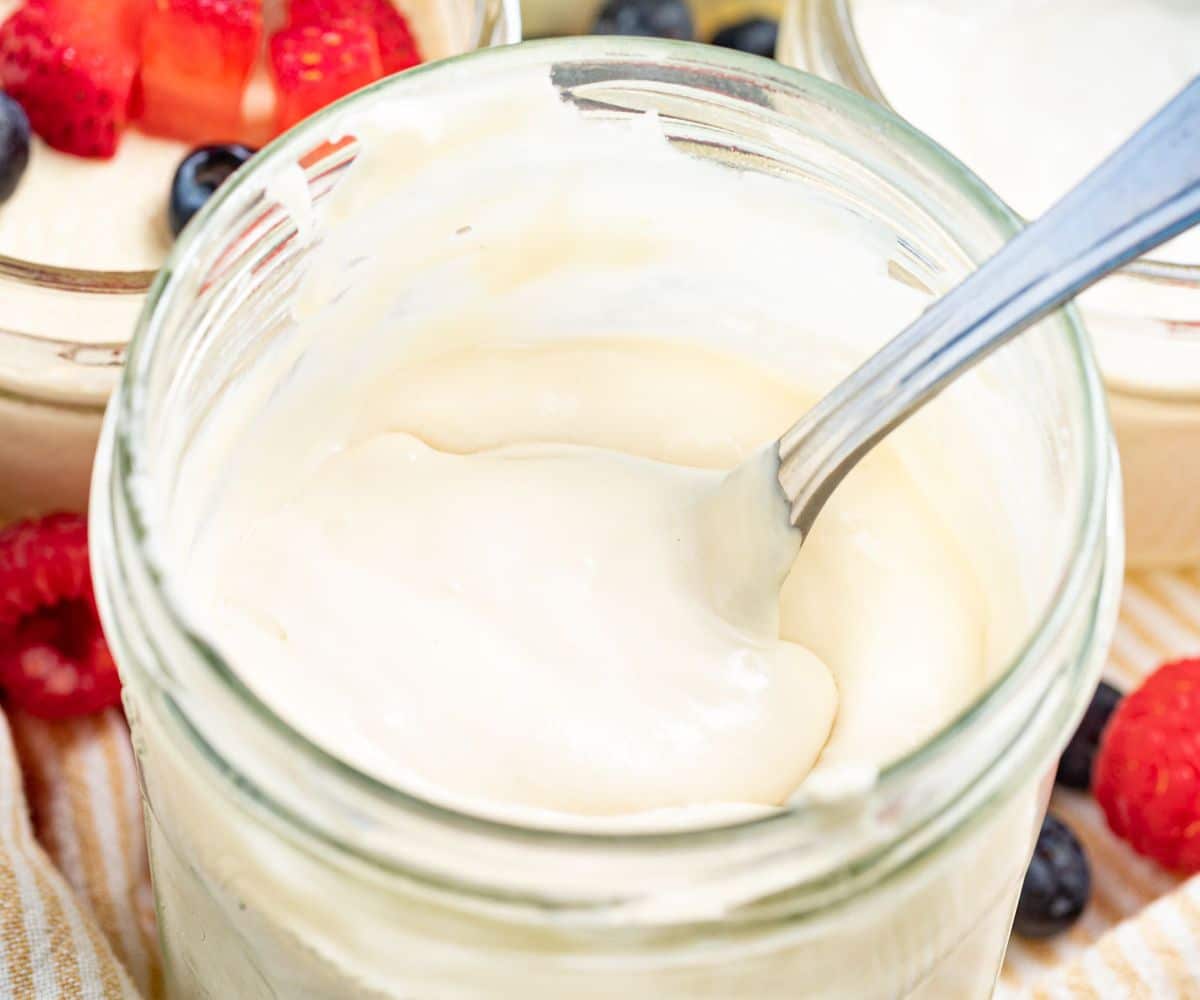
IMPORTANT! Before you eat it all remember to save a few tablespoons of yogurt to culture your next batch!
How To Culture Yogurt Without An Instant Pot
The easiest way to incubate and culture your homemade vegan yogurt is with an Instant Pot that has a yogurt setting. That will keep it at a consistent temperature with no effort from you. And it's no secret that I love my Instant Pot. I use it for something nearly every single day, including recipes like my Instant Pot Black Beans, Instant Pot Portobello Pot Roast and Instant Pot Tomato Soup and also for cooking rice, grains, and oatmeal, etc.
A yogurt maker will work well too and if you don't have either of those then you will need to keep your yogurt at a temperature of between 29 ° C (85 ° F) and 46 ° C (115 ° F). Anything below 29 ° C (85 ° F) and you'll have trouble getting it to culture.
It is also really important that the yogurt doesn't get close to or above 49°C (120 °F) because at that temperature the yogurt cultures will start to be killed off and the recipe won't work. Because of this I highly suggest you check the temperature of the yogurt's location with a thermometre before you start incubating it if you aren't using the controlled environment of an Instant Pot or yogurt maker.
Here are some suggestions for ways to keep your yogurt warm so it cultures successfully:
- Warm house? - If your house is around 29 °C (85 °F) or more you can leave the covered jars on your countertop away from direct sunlight and in a spot where they won't be disturbed.
- In your oven - Preheat your oven to 200 ° C (400 °F) for 1 minute then turn it off. Sit your jars on a baking tray and place them in the oven on the top shelf with the oven light on. Do not open the door for at least 10 hours or the heat will escape.
- Use your home heating - Place your jars of yogurt near (but not too near) the furnace, radiator, fireplace, and stove.
- On top of your fridge/fridge freezer - This is usually a nice warm spot and works well if you don't have built-in appliances.
- In the airing cupboard - If you are in the UK in an older house you might well have one of these.
- A warm closet - I have forced air heating in my house and the closets have vents inside that keep them warm. A spot like that would be ideal.
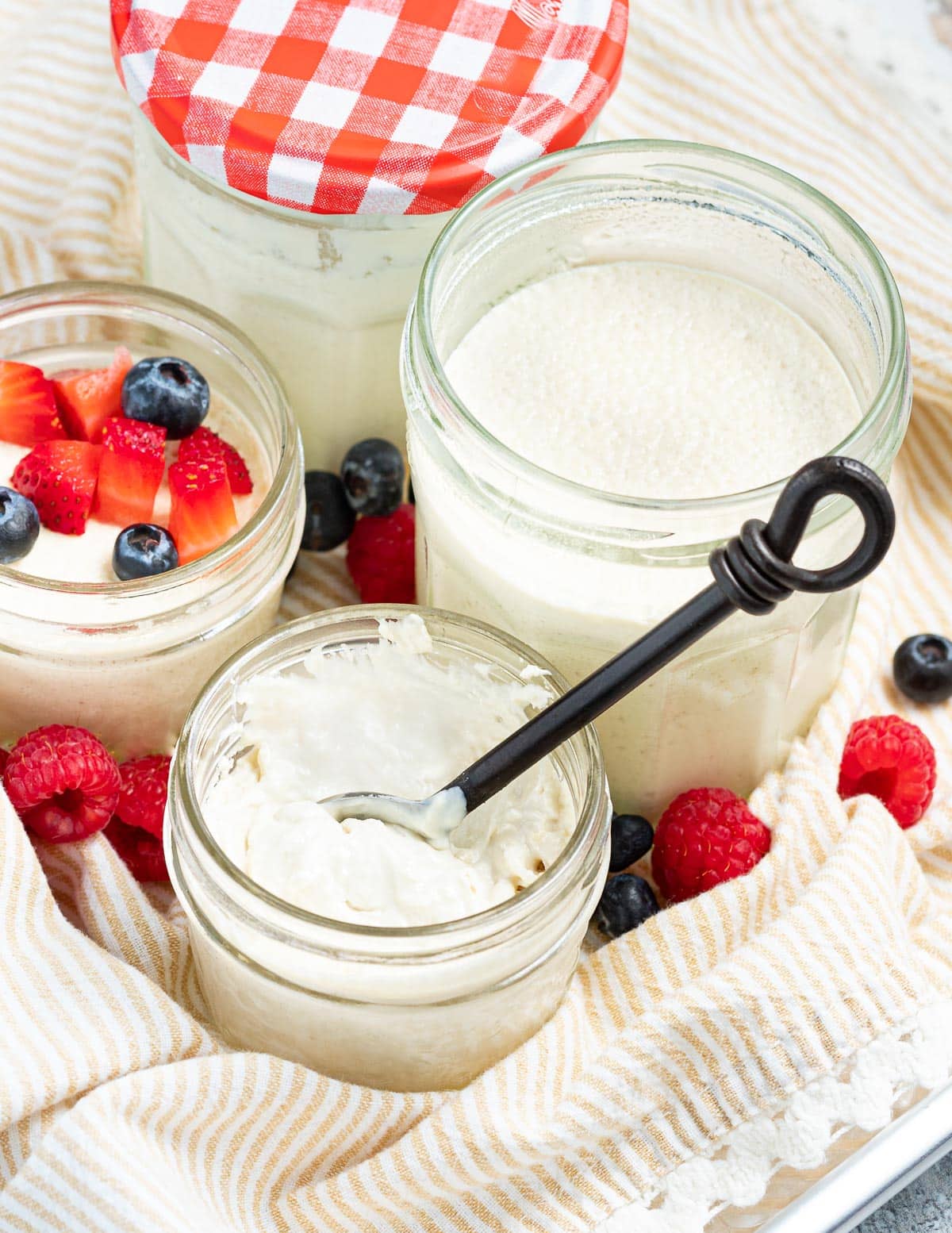
Yogurt Success Tips
- Follow the recipe exactly. Vegan yogurt is finicky. If you make any changes at all it might not work.
- Be sure to soak the cashews even if you have a high-powered blender. We want this yogurt super-duper smooth.
- Do not omit the sweetener. It is necessary for the bacteria to feed on.
- Canned light coconut milk should be used to make this vegan yogurt recipe. I don't recommend using full-fat coconut milk as it will make the yogurt too firm and it also tends to cause separation. Don't be tempted to buy full-fat canned coconut milk and dilute it yourself to make "light" coconut milk. That will not work in this recipe.
- Ensure the yogurt you use to "seed" your yogurt is a cultured/live one. Most are but double-check. If you don't like the results using a particular brand of yogurt try another one next time. Better quality yogurts will give better results.
- Makes sure everything is very, very clean.
- For this recipe, I recommend incubating the yogurt in glass jars. I do not recommend you make it in one big pot, like the Instant Pot's inner pot. This is because this yogurt gets the very best texture when it is completely undisturbed while it incubates and chills. If you stir it or disturb it you will lose the lovely thick, creamy texture.
- If using an Instant Pot do not set your jars on the trivet. They need to be directly in contact with the inner pot. Don't use the trivet at all.
- Don't use metal utensils, pots or bowls as there's a small chance prolonged contact with them could harm the bacteria in the yogurt.
- Try not to disturb the yogurt in the jars. It gets much thicker if you leave it well alone.
- I like to make my yogurt just before I go to bed. That way the incubation time happens while you sleep.
How To Flavour Homemade Yogurt
I don't recommend adding anything before culturing your vegan yogurt because it might hinder the process, but after it has cultured and chilled and you are happy with the tanginess feel free to stir through:
- vanilla or other extracts and liquid sweeteners such as maple syrup
- roasted strawberries, fruit jam, conserves, or fresh fruit
- vegan lemon curd, blueberry lavender sauce, or frozen berry compote
- defrosted frozen berries
- date caramel
- stewed or canned fruit, applesauce, or apple butter (I have recipes for Instant Pot Apple Butter, Stovetop Apple Butter, and Slow Cooker Apple Butter).
Serving Suggestions
Uses for vegan yogurt are wide and varied. I suggest keeping a jar in the fridge at all times so that you can eat it on repeat for breakfast, snack, and dessert!
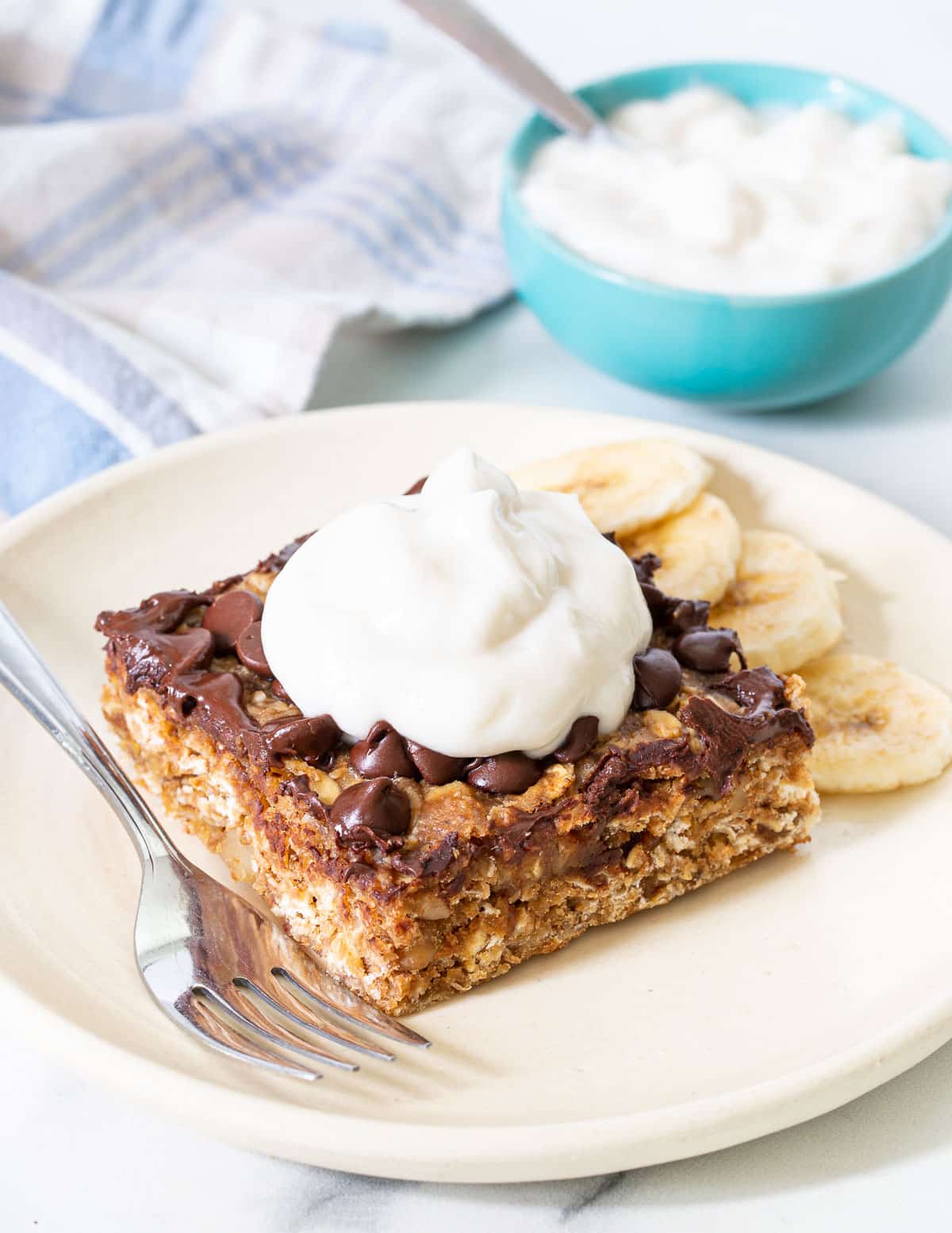
My favourite ways to enjoy yogurt include:
- With spicy curries like my Chickpea Lentil Curry or Red Lentil Dal.
- In my Emergency Strawberry Cheesecake Bowl and Cheat's Banoffee Pie Bowl.
- In Bircher Muesli or my Emergency Strawberry Cheesecake Bowl
- On pancakes or waffles or healthy breakfast bars (pictured above).
- In smoothies
- With vegan granola or chocolate coconut granola and fresh fruit
- As an ingredient in sauces, dips, and baked goods like my Vegan Apple Cake recipe.
What Makes This Yogurt So Thick & Creamy?
If you've made vegan yogurt in the past you've probably found that it usually turns out quite thin and you might be wondering what you can do to thicken your homemade vegan yogurt.
It's hard to make thick vegan yogurt without adding a thickener of some kind. Store-bought vegan yogurts all contain them. The most common thickeners are agar, tapioca flour, or xanthan gum.
In this recipe though we blend soaked cashew nuts into the light coconut milk to naturally thicken the yogurt. The combination of the creamy canned coconut milk, the cashews, and the fermentation process makes it a really thick and creamy vegan yogurt.
Recipe FAQs
Most vegan yogurt contains the same gut-friendly probiotics that non-vegan yogurts do, including this recipe, which when made the first time is "seeded" with probiotics from a store-bought yogurt and then cultured.
Not at this time. I have only tested this yogurt with cashew nuts. If you use anything other than cashew nuts I cannot guarantee that the recipe will work. I think it should work if you omit the cashews but the yogurt will be much thinner. Please note that I have not tested it that way though so if you try it you do so at your own risk.
A lot of plant-based milk will not make successful yogurt. This recipe works well and consistently when using light canned coconut milk. I do not recommend using any other milk as there is a good chance it will not work well or even at all.
There is a chance that despite your best efforts you might get some separation occurring. Just stir it in and pop the jar back in the fridge. Often that's enough to get it to stay nicely homogenized.
If there's a lot of separation you have 2 options:
Scoop off the creamy top, put it in a clean jar and discard the watery part.
Strain it. Line a sieve with cheesecloth and sit it over a bowl. Pour in the yogurt and cover the top with a clean, fluff-free cloth or more cheesecloth. Place the whole thing in the fridge for 24 hours. The liquid will slowly drip out into the bowl leaving you thick and creamy yogurt in the sieve. Once 24 hours have passed, scoop the creamy yogurt into a lidded jar.
Use it in place of milk, sour milk, sour cream, buttermilk, evaporated milk or yogurt in any recipe. Add it to smoothies. Use it as the liquid in pancakes, waffles, cakes or muffins.
If it smells funky (cheesy or foul) or if there is any mould in it then it is important you don't eat it. Discard or compost it.
This is likely either temperature related (it was too warm or too cold), the yogurt you used to "seed" it wasn't a live one with probiotics in it, or the yogurt you used to "seed" it wasn't stored correctly either before or after you got it and the bacteria were no longer active.
Sugar is necessary for the bacteria to feed on so you need to add it in some form. Agave or white or cane sugar will work. Don't use dark-coloured sugar because it will affect the appearance of the yogurt.
Did you omit the maple syrup? This is necessary for fermentation. Without it the bacteria will start dying off before the fermentation process has completed. When this happens an "eggy" sulphur smell can occur. Not sterilizing things properly can also cause issues.
Recipe
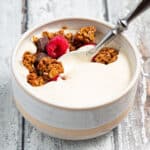
Vegan Yogurt Recipe
Author:Ingredients
- 1 cup (140 grams) raw cashew nuts
- 1 standard can (400ml / 13.5 oz) light canned coconut milk (this recipe won't work well with any other milk)
- 2 tablespoons vegan yogurt , It must contain live probiotic cultures. Note that you only need store-bought yogurt the first time you make this recipe. For subsequent batches, you can use your homemade yogurt.
- 2 tablespoons maple syrup , or agave or the same amount of white or cane sugar (do not omit)
RECOMMENDED EQUIPMENT
INSTRUCTIONS
- Make sure everything you will be using is scrupulously clean. I run my glass jars, and lids through the dishwasher on the hottest setting. You can also wash them in hot soapy water and put them on a baking tray in an oven at 135 °C (275°F) for 15 to 20 minutes or clean the jars in hot soapy water, rinse them, then put them still drippy and wet into the microwave. Microwave on high for 45 seconds (do not put metal lids in the microwave - Soak them in boiling water). I also wash my blender jar in hot soapy water, then rinse and fill it with boiling water, let it sit for a few minutes then pour it out.
- Put the cashews in a small bowl and cover them completely with boiling water. Leave them to soak for 20 to 30 minutes. Don't skip this step.
- Run boiling water through your sieve then drain the cashews and add to a blender. Add the light coconut milk, yogurt, and maple syrup. Blend until completely smooth.
- Decant the mixture into clean and dry glass jars. You cannot make this in the metal Instant Pot insert. Any combination of jar sizes that will hold a total of about 600ml (just under 3 cups). Make sure the jars you choose fit easily together inside the metal inner bowl of the Instant Pot before you start filling them.
- If using an Instant Pot - Place the uncovered yogurt filled jars into the metal inner pot of the Instant Pot. Do not use the trivet and do not add any water to the pot. The jars should be in direct contact with the bottom of the pot and have no lids or other covering on them. Place the lid of the Instant Pot on and close it, then close the steam vent. Press the yogurt button (check that the display says "normal" and not "boil", then adjust the time depending on how long you would like your yogurt to ferment. I suggest a minimum of 10 hours. That will give you a nice thickness and a slight tang. 11.5 hours will give you a more pronounced tang. Do not disturb the Instant Pot/yogurt during this time. You can check it after 10 or 11 hours though. Use a spoon to take a little bit from one jar (without stirring it up first)and taste it. Put the Instant Pot back on again for another hour or two if it's not quite tangy enough.
- If you don't have an Instant Pot - Cover the filled jars with cheesecloth, clean fluff-free dish towels/cloths, any clean breathable fabric, or paper towels and elastic bands or string to hold it in place. To culture successfully you need to keep the yogurt at a consistent temperature of anywhere between 29 ° C (85 ° F) and 46 ° C (115 ° F). If your house is 29 °C (85 °F) or more you can leave the covered jars on your countertop away from direct sunlight.If your house is cooler than that, turn your oven to 200 ° C (400 °F) for just 1 minute and no longer. Then turn it off and turn the oven light on. Place the covered jars on a baking tray (for stability) in the oven on the top shelf, with just the oven light on. Do not open the door while it is culturing or you will let the heat out. Also make sure that no-one turns the oven on. A note stuck to the door is a good idea. Do not disturb the yogurt while it is culturing. At 38 ° C (100 °F) the yogurt will take between 10 to 12 hours to culture, thicken nicely and get a good tang. If the temperature is cooler than that it will take longer and if it's warmer then it will happen more quickly. I suggest testing it by scooping a tiny bit out and tasting it after about 10 hours, then add on more time if you want it to be tangier. If you don't use an Instant Pot or yogurt maker which will control the temperature and keep it consistent, I would highly suggest you check the temperature of your chosen location with a thermometer. It is really important that the yogurt stays consistently between 29 ° C (85 ° F) and 46 ° C (115 ° F). If it doesn't the recipe will not work.
- Once the yogurt has incubated and has reached the right amount of tanginess for you, cover securely with a lid and refrigerate thoroughly. Do not stir it. For best results it needs to be undisturbed until completely chilled. It will thicken more as it chills and will continue to thicken the longer you leave it before eating.
- Remember to save a few tablespoons of your yogurt so that you can use it to culture your next batch of homemade vegan yogurt.
- If you prefer a sweet yogurt, add more sweetener after the yogurt has fermented and chilled and not before.
NOTES
💌 SAVE THIS RECIPE!
Watch out for more tasty treats coming your way too! Unsubscribe at any time.


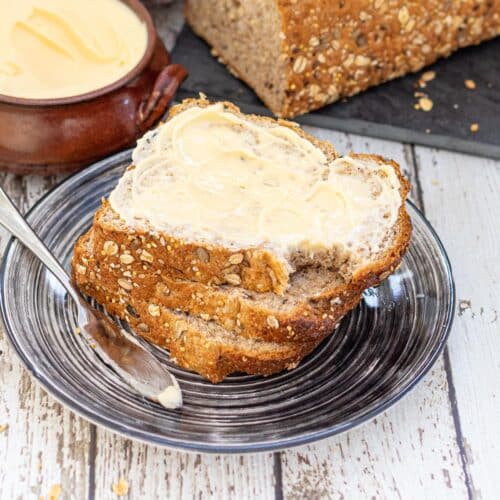
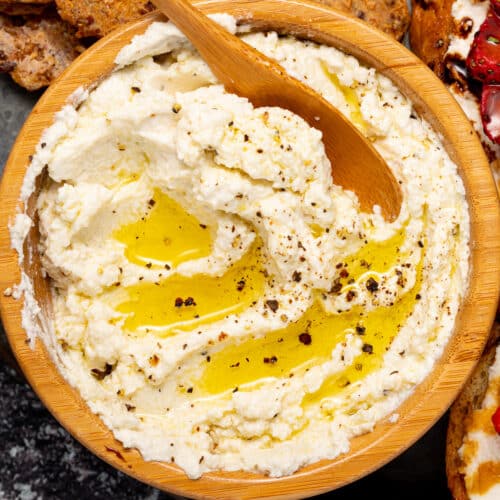

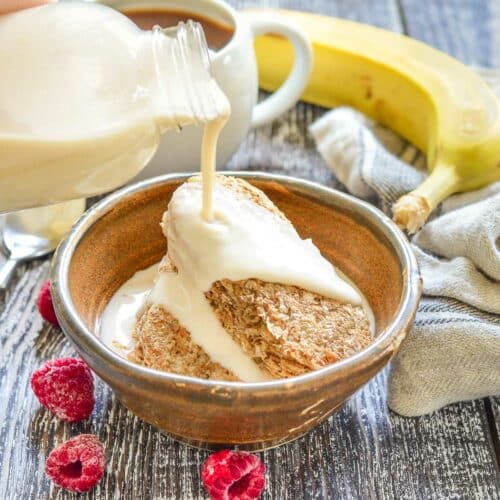
Skye says
I followed the recipe almost to the letter, the difference being I added a few extra cashews, literally that's it.
I got raw cashews, I got light canned coconut milk, soaked the cashews for 25mins, blended it all, the yoghurt mixed in, left them on bench for around 18-24hrs... It's the runniest/thinnest homemade vegan yoghurt I've ever experienced through trying out different recipes.
I added the extra cashews because in my experience with making my own homemade cream, I knew this recipe would be relatively runny based on the ingredients and method but thought the extra cashews would help but they didnt. I'll have to go back to my cream recipe and tweak that as it's a no from me, and my toddler too unfortunately as he didn't approve 😞
Melanie McDonald says
This recipe makes really thick and creamy yogurt (without extra cashews). All of my recipes are thoroughly tested and reliable.
You say you left your mixture "on the bench" for 18-24 hours. You need a very consistent temperature of between 29°C (85°F) and 46°C (115°F) to ferment yogurt so unless your kitchen/the bench is extremely warm (and most peoples homes won't be anywhere near that temperature) then the yogurt won't have cultured. Not keeping it at the correct temperature will have made it runny.
D. says
I haven't made this yet but am intrigued! I had been making coconut yogurt for a while with full fat, using brand Aroy-D in Asian grocery. BUT I've since discovered they put a chemical in their milk and that's probably why the milk is so silky smooth when you pour it out of the can...no separation, like other brands. My question is does the light canned coconut milk you use have any gums in them and if they do not have the guar gum in them, will the result still be a lovely thick yogurt?? If you can recommend certain brands you've tried, that would be helpful! Thanks!
Melanie McDonald says
The recipe was tested with all the available brands of light coconut milk from my local grocery stores and it didn't make a difference to the results whether they contained guar gum or not. I personally usually use Cha's Organic or Everland coconut milk because they are monkey friendly.
Hope you enjoy the recipe!
P says
Your recipe is amazing, I’ve been having a great time eating yoghurt again.
However, this last time I used my own starter (which had been in the instant pot for 15 hours) and the yoghurt had split - the water was at the base of the jar and the yoghurt had granules.
I stirred it all together and tried it - it still has granules and taste very tangy (the first mouthful was a tad fizzy).
Do you have any idea why this might have happened?
Everything was cleaned and I didn’t deviate from the recipe. I wonder if it was because the starter I used had been on for 15 hours and was a little too fermented.
Any insight would be really grateful.
Thank you!
Melanie McDonald says
So pleased you're enjoying the recipe! If your yogurt is feeling/tasting fizzy that's a sure sign that it's over fermented. Splitting is also a sign of over-fermentation. If using an Instant Pot on the yogurt setting then it's unlikely the temp was too high, so reducing the time should fix the issue next time.Hope that helps!
Marcella Pope says
I am excited to try but my instapot does not have a yogurt setting...can I do it in a dehydrator?
Melanie McDonald says
I've never tried it and don't know what temperature they run at to make a guess. Whether it would be too cool or too warm for culturing to happen I don't know. I give lots of other suggestions for how to do it without an Instant Pot in the post though so maybe one of those methods will work for you.
Nicole says
Hi! I was very excited to try this recipe. First time it did not thicken. It tasted good but only the consistency of a thin custard.
I tried it again and just got it out of the instapot after 10.5 hours and it is still thin. I used a different vegan yogurt this time thinking the yogurt was the issue.
Does the thickening happen only during cooling? I am confused why it is not thickening. Thoughts?
Melanie McDonald says
It should be really thick before it cools, then get even thicker once it's refrigerated. Like in my process pictures. It could be for a number of reasons:
- A weak starter is the most likely..Is the yogurt you are using to start it a good quality live one. Try a different brand.
- Not enough sugar for the bacteria to feed on. The maple syrup/sugar is essential in this recipe. I know some people have omitted it and that has lead to the yogurt not setting.
- Contaminated equipment. Make sure everything (jars, spatula, blender etc) is freshly washed and scrupulously clean.
- Inconsistent or incorrect temperature.
Hope that helps!
Dina K says
Amazing! Mine was a thin, but firmed up overnight. I used an open big container of vegan yogurt -- next time I will use a fresh, unopened yogurt and see if that's what was needed. This is delicious yogurt thank you!
I do have one question please. My yogurt maker and its containers could handle a double batch. Could I just double the ingredients and blend all together at once, or do I need to make two rounds in the blender, one at a time as written, to fill my glass jars?
Thanks!
Melanie McDonald says
I should think you can just double it. So pleased you're enjoying the recipe!
Linda says
Omg this is the BEST recipe. I have been making it non-stop for over a month now. So many recipes out there had thickening agents. But I noticed they didn’t drain the water from cashews, probably why. Follow the instructions to the “T” like she says and you will have perfect creamy yogurt that is so much healthier than store bought and a good keto choice as well. Thank you so much!
Janet says
Hi Melanie
I have a pressure king pro without a yogurt setting, any idea if I can make your recipe in it?
Melanie McDonald says
I'm not familiar with that brand but if it has a yogurt setting then it will be fine. If it doesn't then you won't be able to use it. The yogurt setting keeps the temperature at about 43°C (110°F). Any other setting on a pressure cooker will be too hot and kill the bacteria. As an example even the "keep warm" setting on an Instant Pot is way too hot at about 65°C - 78°C (150 - 172°F) and that's probably more or less the same across all electric pressure cookers.
Instructions are included for making it without an Instant Pot though so if you can't use your pressure cooker you can still make it using one of those methods.
Hope that helps!
Tina says
I do not have an actual "Instant Pot", rather another brand pressure cooker with a yogurt setting. I did end up altering the cooking method because of this, but...Perfect! It's thick and tart! Thank you so much! My daughters are in heaven!
Melanie McDonald says
Thanks so much, Tina! I'm really pleased it worked out well in your pressure cooker!
Dorinda says
Well, I decided to try the recipe with walnuts... the texture is somewhat grainy (not smooth like using cashews). There was whey in the bottom of each glass jar with walnut yogurt above. I made a narrow space along the side of the jar and poured the whey into a separate container to use with my smoothies. I added some homemade apple jam to the walnut yogurt and it tasted good. BUT, the texture and taste of the cashew yogurt recipe is definitely the winner for taste and texture!!
Summer says
I just made this. I think it is wonderful. It will be my go-to recipe! Thank you!
Sammy says
First time I did not use canned light milk and filled jars to the top and put lids on them and the yogurt 'expanded' and leaked.....but it tasted really good and was super thick (wasy I like it). I am now making a 2nd time and used 3/4 cups soaked cashews and put water to thin the full fat coconut milk (I only buy this type) and added a little extra maple syrup. I left some room in th jar this time so let's see what happens.
Dorinda says
Sammy, you don't want to put tops on the jars until they are ready to be put in the refrigerator :)
Dorinda says
SO GRATEFUL for your diligence and detailed instructions!!! Ive made 2 batches...one single and one doubled with great results!! I also used half the recommended starter yogurt plus capsules of probiotic-- ratio: 1:1 and the yogurt is so YUMMY!! I put a large pot of hot water on to boil. Then, took jars from dishwasher and put in cake pan- put in oven at 275. I filled pint jar with cashews (for double recipe) and boiling water and let sit for 30 min Then I followed your instructions. I used my instant pot but removed the rubber ring (stinky), closed the vent and the yogurt turned out fine :) Thank you for a GREAT recipe!!!
Paula says
This is one of the best plant based yogurts I have eaten. It is certainly easy to make. I love it sprinkled with Grape Nuts cereal and blueberries. thank you
Janice says
I bought a yogurt maker a number of years ago so that I could make some non-dairy yogurt, but it didn't work. I'm allergic to dairy, eggs, & gluten, so I have a challenge. At that time, there really wasn't any vegan yogurts that were worth eating. So saying all that, I just tried my first jar of yogurt from your recipe. It wasn't what I expected, I thought it would be tangy, but it is delicious!!! I just had to go back and get a second jar! I'll be stocking up on "light" coconut milk in the can so I can keep making it! I only wish the recipe made two more jars of yogurt, as my yogurt maker holds seven. Thank you sooo much for sharing this recipe!
Ginny Bates says
Hi! I'm the one who had no maple syrup, used white sugar, and ended up with lovely though very sweet yogurt.
I tried again yesterday. I still doubled the recipe. I used a scant one tablespoon of white sugar. My Vitamix blended the cashews and milk beautifully smooth but in the process, overheated the mixture (I checked with a thermometer before adding my starter). Being in a hurry, I added nearly a cup of soy milk from a carton in the fridge. It was a soy beans and water only formula. I was a little skeptical about what I had done but figured the yogurt could always be used for smoothies with frozen fruit. I did culture a long time - something like 18 hours. It was tangy like we prefer, thick, and NOT sweet! Hooray! An added benefit is that the soy milk addition gave me more yogurt for fewer calories. Raita with cucumber (which is wonderful not only as an Indian condiment, but terrific mixed with cold rice in the summer for a light meal) is in my future.
Carol says
Can this be done in a crockpot?
Melanie McDonald says
I've never tried. I would guess though that the minimum temperature of a crockpot would be too hot to culture yogurt.
Lesie says
Do you think this would work using a probiotic instead of a vegan yogurt?
Melanie McDonald says
I've never tried it that way.
Janice says
My yogurt is slightly runny and thin and tastes heavily of cashews. I left it in the Instant Pot for 16 hours. Do you know what could cause this? I see in the comments that you said if it's thin it could be that the starting yogurt may not been stored properly so the probiotics were not active. That's frustrating because how would I know that when buying it? I'm eating it because it's not bad at all just different from the result my friend got. Do you have any suggestions for success in the future? I'll be making it again! Thank you so much!
Doro says
16 hours is way too long....I like mine after 6 hours.....When I wait for 8 hours it is still fine but a bit more tangy--just depends on your taste-buds.
Gail Nelson says
Hi,
Can you use honey instead of maple syrup?
Melanie McDonald says
This is a vegan recipe. Honey isn't vegan.